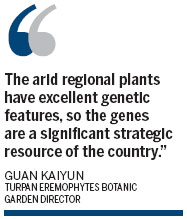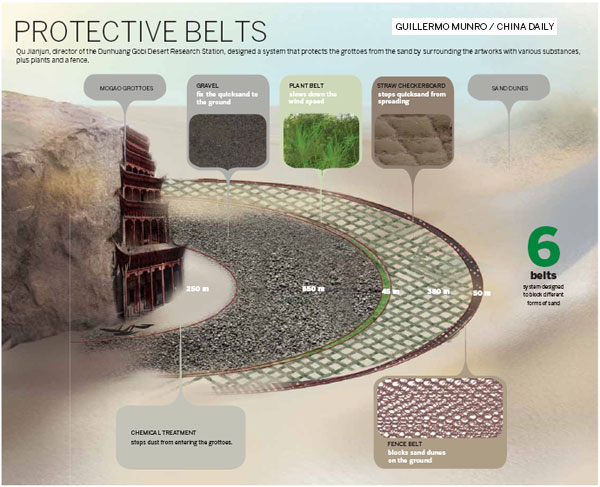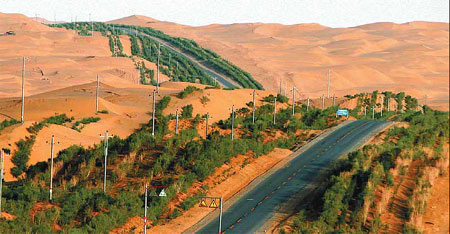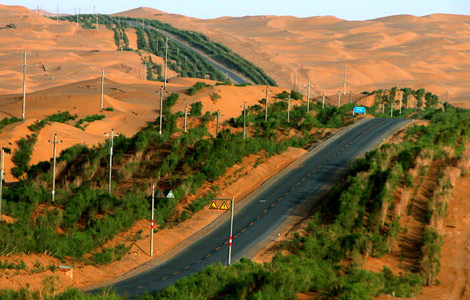Scientists make land arable again
Updated: 2013-09-16 08:20
By Cheng Yingqi (China Daily)
|
||||||||
The spread of sand in Xinjiang stops, and a major road to Urumqi is saved
For 2,000 years, people have battled the relentless wind and sand of the unforgiving Taklimakan Desert.
Ancient civilizations along the Silk Road were swept aside, leaving traces of their existence only in the remains of temples and frescos.
Qira county in the southwest of the Xinjiang Uygur autonomous region is one of the most severely hit regions.
Without scientific methods to combat desertification, the march of the sands of time would have continued.
But scientists have found an oasis of triumph after three decades.
The Qira research station of the Chinese Academy of Sciences was established in 1983. With the help of the scientists from the station, a transitional zone was established, and gradually the sand was pushed back more than 5 kilometers.
Jappar Mashrap, 49, lives in Qira and has witnessed the change and benefited from the work of the scientists.
Mashrap's endangered home was on the fringe of the desert and the family had to move in the late 1960s as the sand crept closer.
But thanks to the work of the scientists, the desert's march was stopped and Mashrap has a home again.
"Now on Children's Day, people often take their children to the amusement park, but things were quite different when I was a boy," Mashrap said.
"In those days, to celebrate festivals, my parents had to take me a long way to find grass where we could play."
The sand also threatened a major road running through on the north-south axis of the Taklimakan Desert.
The 562-kilometer road, completed in 1995, shortens the route between Urumqi and Hotan by 500 km. But it had been plagued by problems caused by the sand.
Xu Xinwen, director of the station, and his team devoted much of their efforts to securing the road.
"Sometimes the sand on the road piles up a few meters high," Xu said. Various methods were tried, including fencing and barriers, but each had a drawback.
"The most effective barrier for sand is greening," Xu said.
However, in a desert that has annual precipitation of just 10 millimeters, "planting a tree and nurturing it to full growth is even more difficult than raising a child", Xu said.
Xu found seeds and plants that can survive in the bitter salt water under the sand, such as Chinese tamarisk, calligonum and Haloxylon ammodendron.
Since 2003, 20 million drought-enduring plants have been planted along the road, forming a 72-to 78- meter green belt.
The plants are irrigated by underground water pumped up 114 water wells. Compared to the cost of maintaining fences and barriers, irrigating the plants save some 30 million yuan ($4.9 million) every year.
The discoveries and applications of the desert plants is a lengthy process, according to Guan Kaiyun, director of the Turpan Eremophytes Botanic Garden.
"Our researchers working in the stations find the plants and seeds, and we are in charge of plant introduction and acclimatization, which sometimes takes more than a decade to finish," Guan said.
In the parched Turpan Basin sits the world's only botanic garden of Asian desert flora. When a new plant is found, the samples are usually taken back to the garden, where scientists find ways to help the plants adapt to the new environment.
Spending four decades introducing and preserving desert plants, the botanic garden now has 700 different species, 50 of them endangered. Estimates put the number of plant species in the desert at about 5,000.
The plants also provide scientists with research opportunities.
One example Guan gives is Ammopiptanthus nanus, an endangered evergreen shrub in Xinjiang on which scientists recently extracted a protein that can combat deep cold.
"That protein explains the reason that Ammopiptanthus nanus survives the extreme low temperatures. And it's worth further study because we might use it in genetically modified techniques in the future," Guan said.

Tian Changyan, deputy director of the Xinjiang Institute of Ecology and Geography, has devoted 10 years to finding the perfect plants that could improve the saline-alkali soil.
"Some plants can only grow in excessively saline soil. If we cultivate these plants on moderately saline soil, the plants will extract the salt out of the soil and improve its fertility," Tian said.
From 305 different salt-tolerant species, Tian identified six that were the most efficient. Experiments on a 67-hectare test field showed the plants were able to reduce the soil salt from 3 percent to less than 0.6 percent within three years.
"Compared to the old method of washing the saline soil with water, the plants are much more effective and sustainable," Tian said.
Scientists at the Xinjiang Institute of Ecology and Geography have devised a major project which could change the landscape forever. By 2020, the institute will build a gene bank of arid regional plants covering 10,000 plant species. Also, a world-class botanical garden is planned for Ili Kazak autonomous prefecture.
"The arid regional plants have excellent genetic features, so the genes are a significant strategic resource of the country," Guan said.
"The genes have great potential for our future development of agriculture, medicine and the military."
chengyingqi@chinadaily.com.cn

|
The 562-kilometer road connecting Urumqi and Hotan, which once was plagued by problems caused by the sand, now has desert plants as protection. Provided to China Daily |

(China Daily USA 09/16/2013 page7)
Most Viewed
Editor's Picks

|

|

|

|

|

|
Today's Top News
US top carpet maker sets up in China
States laud lifting of ban on hardwood by China
UN chief gets report on Syria chemical weapons
Succession proves a tricky art in business
Going global? Not so easy
Japan switches off nuclear reactor
Summers withdraws from Fed chair contest
Chinese FM hails US-Russia deal
US Weekly

|

|
















